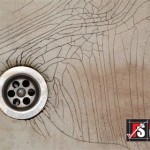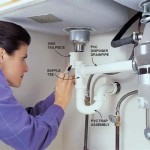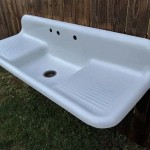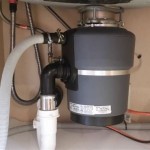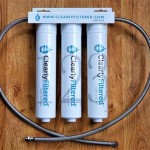Drano Not Working: Troubleshooting a Clogged Bathroom Sink
A clogged bathroom sink can be a significant inconvenience. Often, the first recourse for homeowners is to reach for chemical drain cleaners like Drano. These products are marketed as quick and easy solutions for dissolving common drain obstructions. However, there are instances when Drano, despite being used as directed, fails to clear the clog. Understanding why this might occur and what alternative solutions exist is crucial for effectively resolving the plumbing issue.
Drano's effectiveness is predicated on its chemical composition. The active ingredients, typically sodium hydroxide (lye) and sodium hypochlorite (bleach), react with organic materials that commonly cause clogs, such as hair, soap scum, grease, and toothpaste. These reactions generate heat, which aids in breaking down the blockage. However, certain types of clogs or specific sink conditions can limit Drano's ability to perform as intended.
The viscosity of Drano is also a factor. It is designed to be thick enough to sink through standing water and reach the clog. If the clog is situated deep within the drainpipe or if the sink is excessively full of water, the chemical solution may become diluted, reducing its potency. Furthermore, the design of the drainpipe itself, especially the presence of sharp bends or p-traps filled with debris, can impede Drano's progress towards the obstruction.
Before exploring alternative solutions, it's important to consider the potential reasons behind Drano's failure. Identifying the likely cause can inform the choice of the subsequent unclogging method, leading to a more successful outcome and preventing further damage to the plumbing system.
Understanding Why Drano Might Fail
Several factors can contribute to Drano's ineffectiveness. These can range from the nature of the clog itself to improper application or pre-existing conditions within the plumbing system.
One common reason is the composition of the clog. Drano is most effective against organic matter. If the clog primarily consists of inorganic materials like mineral buildup, small objects (such as jewelry or bottle caps), or hardened masses of toothpaste that have calcified over time, Drano will likely have limited impact. These materials are resistant to the chemical breakdown process that Drano relies on.
Another factor is the severity and location of the clog. A minor blockage near the surface of the drain is typically easier to dissolve than a large, compacted clog located deeper within the drainpipe. If the clog is dense and firmly lodged, the chemical solution may not be able to penetrate it effectively, preventing complete dissolution. Furthermore, clogs located beyond the reach of the Drano solution, perhaps further down the drain line, will obviously not be affected.
Improper use of Drano can also contribute to its failure. It is crucial to follow the instructions on the product label carefully. Using too little Drano may not provide sufficient chemical strength to break down the clog, while using too much can potentially damage the pipes or create a dangerous chemical reaction. Leaving Drano in the drain for too short or too long a period can also reduce its effectiveness. Furthermore, mixing Drano with other drain cleaners can create hazardous fumes and should be strictly avoided.
Finally, pre-existing conditions within the plumbing system can hinder Drano's performance. Corroded or damaged pipes may have rough surfaces that trap debris and exacerbate clogs. A slow-draining sink, even before the full clog develops, can indicate a partial blockage that has allowed debris to accumulate over time. In such cases, Drano may only provide temporary relief, and the clog is likely to return quickly. In older plumbing systems, the pipes themselves may be narrower, making them more prone to clogs and less receptive to chemical treatments.
Safer Alternatives to Drano
Given the potential for Drano to fail and the risks associated with its use, exploring safer and often more effective alternatives is advisable. Mechanical methods and gentler chemical solutions can often resolve clogs without the harshness of Drano.
The first and simplest approach is the use of a plunger. A standard cup plunger can often dislodge surface-level clogs by creating suction that pulls debris upwards. Ensure there is enough water in the sink to cover the cup of the plunger, and then use firm, consistent plunging motions for several minutes. If the sink begins to drain, continue plunging to ensure the clog is completely cleared. A flange plunger, designed for toilets, can also be used if the drain opening is particularly large.
A plumbing snake, also known as a drain auger, is a flexible tool designed to reach deeper into the drainpipe and break up or retrieve clogs. Insert the snake into the drain opening and rotate it as you push it further down. When you encounter resistance, continue rotating to break up the clog or to hook onto it for removal. Slowly retract the snake, pulling out any debris. Repeat this process until the snake moves freely through the drainpipe. Different types of plumbing snakes are available, with varying lengths and head designs, to address different types of clogs and drainpipe configurations.
A mixture of baking soda and vinegar can provide a gentler chemical alternative to Drano. Pour one cup of baking soda down the drain, followed by one cup of white vinegar. The mixture will fizz and bubble, creating a natural chemical reaction that can help dissolve organic matter. Allow the mixture to sit for at least 30 minutes, or preferably overnight, and then flush the drain with hot water. This method is less harsh than Drano and is less likely to damage pipes.
Another option is using boiling water. This is most effective for clogs caused by grease or soap scum. Pour a kettle of boiling water down the drain, being careful to avoid splashing. The hot water can melt away the grease and soap, allowing the drain to flow freely. This method should be used with caution on PVC pipes, as excessive heat can potentially damage them over time. It is generally safe for metal pipes.
Finally, disassembling and cleaning the p-trap, the curved section of pipe located under the sink, can often resolve stubborn clogs. Place a bucket under the p-trap to catch any water or debris. Loosen the slip nuts that connect the p-trap to the drainpipes and carefully remove the p-trap. Clean out any accumulated debris and rinse the p-trap thoroughly. Reassemble the p-trap, ensuring the slip nuts are tightened securely to prevent leaks.
Preventative Measures for Future Clogs
Preventing clogs in the bathroom sink is significantly easier and more desirable than dealing with them after they occur. Implementing simple preventative measures can significantly reduce the frequency of clogged drains and minimize the need for harsh chemical solutions.
One of the most effective preventative measures is to use a drain strainer. These inexpensive devices fit over the drain opening and catch hair, soap scum, and other debris before they enter the drainpipe. Regularly cleaning the strainer is essential to prevent it from becoming clogged itself. Strainers are available in various sizes and materials to fit most standard bathroom sink drains.
Avoid pouring grease, oil, or other fatty substances down the drain. These materials solidify as they cool, coating the inside of the drainpipe and trapping other debris. Instead, dispose of cooking grease in a sealed container and discard it in the trash. Regularly flushing the drain with hot water after using the sink can also help to prevent grease and soap scum from accumulating.
Regularly flush the drain with a baking soda and vinegar solution. This can help to dissolve any minor buildup before it becomes a major clog. A monthly treatment can be sufficient to maintain clear drains. Remember to follow the instructions for this method carefully, using the correct proportions of baking soda and vinegar and allowing the mixture to sit for an adequate amount of time.
Avoid using excessive amounts of toothpaste or soap. These products can contribute to the buildup of soap scum within the drainpipe. Encourage family members to use only the necessary amount of these products to minimize the amount of residue that enters the drain. Consider switching to liquid soaps or body washes, which tend to produce less soap scum than bar soaps.
Regularly inspect the drainpipe for any signs of leaks or corrosion. Addressing these issues promptly can prevent further damage and reduce the likelihood of clogs. Leaks can create a breeding ground for mold and mildew, while corrosion can roughen the interior of the pipes, making them more prone to trapping debris. If you notice any problems, consult a qualified plumber for repair or replacement.
Finally, consider educating all members of the household about proper drain care. Emphasize the importance of avoiding pouring inappropriate materials down the drain and of using drain strainers. By fostering a culture of drain awareness, you can significantly reduce the likelihood of clogs and maintain a healthy plumbing system.

What To Do If Drano Isn T Working Turner S Service

Best Unclogging Drain How To Unclog A Sink Quickly Unplug Blockages Drano Max Gel Youtube

When Drano Isn T Working Take These 4 Essential Steps To Clearing A Clog

Drano Not Working How To Remove Clogs When Fails Prudent Reviews

How To Fix A Bathroom Sink That Won T Drain Bfp Bay Area

How To Unclog A Bathroom Sink Hana S Happy Home

How To Unclog A Bathroom Sink Hana S Happy Home

Does Drano Work How It Should I Use Smiley Drain Cleaning

How To Unclog A Slow Running Bathroom Sink Drain 10 Options

How To Clear A Clogged Drain Reviews By Wirecutter
